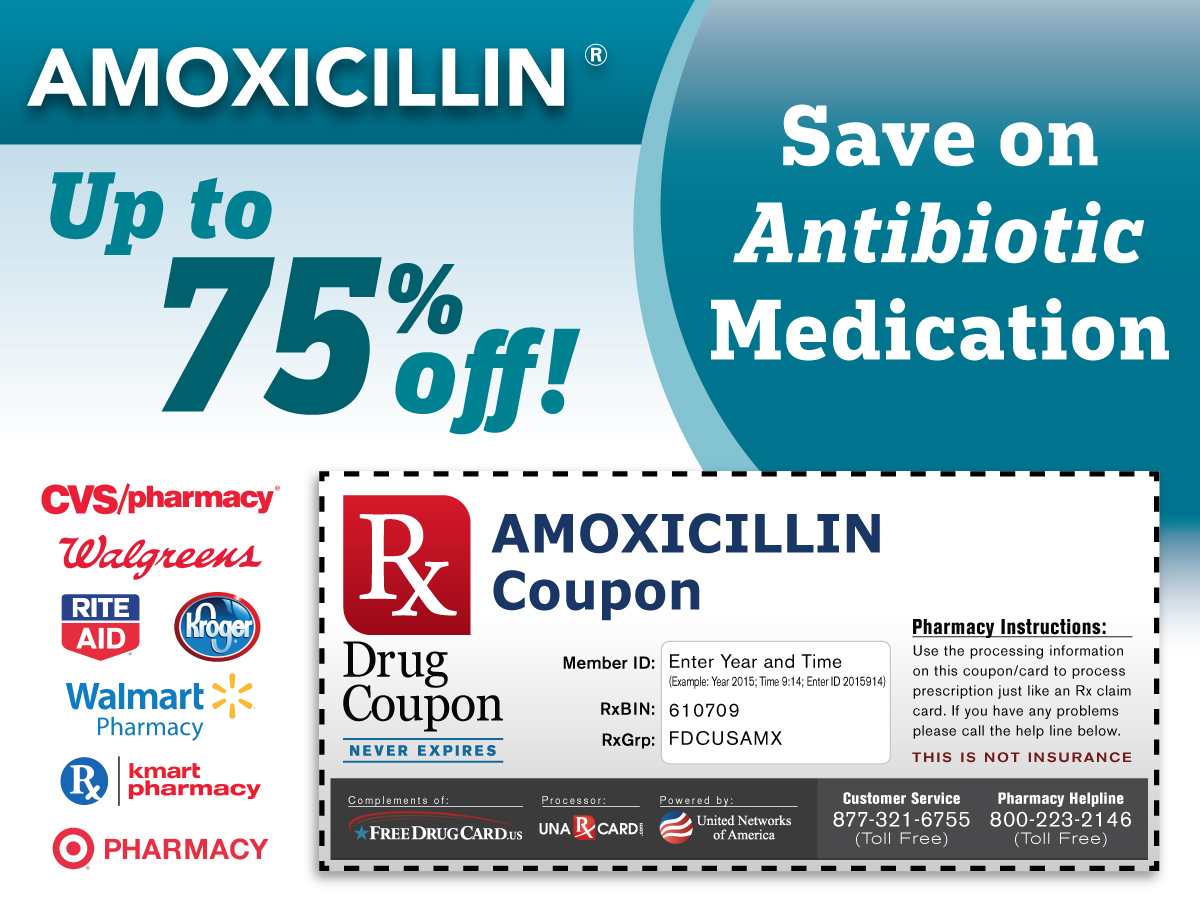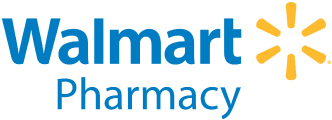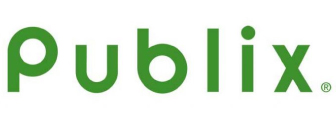Coupons for Antibiotics Prescription Drugs
Free Prescription Drug Coupons! Download your FREE discount coupon(s) below to save money on Antibiotics medication at pharmacies across the country. These coupons are pre-activated and can be used immediately to save up to 90% on your prescription drugs.
| Information | ||
|---|---|---|
| AMOXICILLIN CAP 250MG | Drug Info | |
| AMOXICILLIN CAP 250MG | Drug Info | |
| AMOXICILLIN CHW 125MG | Drug Info | |
| AMOXICILLIN CHW 250MG | Drug Info | |
| AMOXICILLIN POW TRIHYDRA | Drug Info | |
| AMOXICILLIN SUS 125/5ML | Drug Info | |
| AMOXICILLIN SUS 200/5ML | Drug Info | |
| AMOXICILLIN SUS 250/5ML | Drug Info | |
| AMOXICILLIN SUS 400/5ML | Drug Info | |
| AMOXICILLIN TAB 500MG | Drug Info | |
| AMOXICILLIN TAB 875MG | Drug Info | |
| AMOX/K CLAV CHW 200MG | Drug Info | |
| AMOX/K CLAV CHW 400MG | Drug Info | |
| AMOX/K CLAV SUS 200/5ML | Drug Info | |
| AMOX/K CLAV SUS 250/5ML | Drug Info | |
| AMOX/K CLAV SUS 400/5ML | Drug Info | |
| AMOX/K CLAV SUS 600/5ML | Drug Info | |
| AMOX/K CLAV TAB 250MG | Drug Info | |
| AMOX/K CLAV TAB 500MG | Drug Info | |
| AMOX/K CLAV TAB 875MG | Drug Info | |
| AVELOX INJ | Drug Info | |
| AVELOX TAB 400MG | Drug Info | |
| AZITHROMYCIN INJ 2.5GM | Drug Info | |
| AZITHROMYCIN INJ 500MG | Drug Info | |
| AZITHROMYCIN POW 1GM PAK | Drug Info | |
| AZITHROMYCIN POW DIHYDRAT | Drug Info | |
| AZITHROMYCIN SUS 100/5ML | Drug Info | |
| AZITHROMYCIN SUS 200/5ML | Drug Info | |
| AZITHROMYCIN TAB 250MG | Drug Info | |
| AZITHROMYCIN TAB 500MG | Drug Info | |
| AZITHROMYCIN TAB 600MG | Drug Info | |
| CANCIDAS INJ 70MG | Drug Info | |
| CEFDINIR CAP 300MG | Drug Info | |
| CEFDINIR SUS 125/5ML | Drug Info | |
| CEFDINIR SUS 250/5ML | Drug Info | |
| CEPHALEXIN CAP 250MG | Drug Info | |
| CEPHALEXIN CAP 500MG | Drug Info | |
| CEPHALEXIN SUS 125/5ML | Drug Info | |
| CEPHALEXIN SUS 250/5ML | Drug Info | |
| CEPHALEXIN TAB 250MG | Drug Info | |
| CEPHALEXIN TAB 500MG | Drug Info | |
| CIPROFLOXACN TAB 250MG | Drug Info | |
| CIPROFLOXACN TAB 500MG | Drug Info | |
| CIPROFLOXACN TAB 750MG | Drug Info | |
| CIPROFLOXACN TAB 1000MG | Drug Info | |
| CIPRO (5%) SUS 250MG/5 | Drug Info | |
| CIPRO (10%) SUS 500MG/5 | Drug Info | |
| CIPROFLOXACN INJ 200MG | Drug Info | |
| CIPROFLOXACN INJ 400MG | Drug Info | |
| CIPROFLOXACN POW | Drug Info | |
| CIPROFLOXACN POW HCL | Drug Info | |
| CIPROFLOXACN SOL 0.3% OP | Drug Info | |
| CIPRODEX SUS 0.3-0.1% | Drug Info | |
| CLINDAMYCIN CAP 150MG | Drug Info | |
| CLINDAMYCIN CAP 300MG | Drug Info | |
| CLINDAMYCIN CRE 2% VAG | Drug Info | |
| CLINDAMYCIN CRY PHOSPHAT | Drug Info | |
| CLINDAMYCIN GEL 1% | Drug Info | |
| CLINDAMYCIN INJ 150MG/ML | Drug Info | |
| CLINDAMYCIN INJ 300MG | Drug Info | |
| CLINDAMYCIN INJ 600MG | Drug Info | |
| CLINDAMYCIN INJ 900MG | Drug Info | |
| CLINDAMYCIN LOT 1% | Drug Info | |
| CLINDAMYCIN LOT 10MG/ML | Drug Info | |
| CLINDAMYCIN PAD 1% | Drug Info | |
| CLINDAMYCIN POW | Drug Info | |
| CLINDAMYCIN POW HCL | Drug Info | |
| CLINDAMYCIN POW HCL USP | Drug Info | |
| CLINDAMYCIN POW PHOSPHAT | Drug Info | |
| CLINDAMYCIN SOL 1% | Drug Info | |
| CLINDAMYCIN SOL 75MG/5ML | Drug Info | |
| CUBICIN SOL 500MG | Drug Info | |
| DORYX TAB 100MG | Drug Info | |
| DORYX TAB 150MG | Drug Info | |
| DOXYCYCL HYC CAP 50MG | Drug Info | |
| DOXYCYCL HYC CAP 100MG | Drug Info | |
| DOXYCYCL HYC INJ 100MG | Drug Info | |
| DOXYCYCL HYC TAB 75MG | Drug Info | |
| DOXYCYCL HYC TAB 100MG | Drug Info | |
| FLUCONAZOLE POW | Drug Info | |
| FLUCONAZOLE SUS 10MG/ML | Drug Info | |
| FLUCONAZOLE SUS 40MG/ML | Drug Info | |
| FLUCONAZOLE TAB 50MG | Drug Info | |
| FLUCONAZOLE TAB 100MG | Drug Info | |
| FLUCONAZOLE TAB 150MG | Drug Info | |
| FLUCONAZOLE TAB 200MG | Drug Info | |
| FLUCONAZOLE INJ DEX 200 | Drug Info | |
| FLUCONAZOLE INJ DEX 400 | Drug Info | |
| FLUCONAZOLE INJ NACL 100 | Drug Info | |
| FLUCONAZOLE INJ NACL 200 | Drug Info | |
| FLUCONAZOLE INJ NACL 400 | Drug Info | |
| LEVAQUIN INJ 25MG/ML | Drug Info | |
| LEVAQUIN SOL 25MG/ML | Drug Info | |
| LEVAQUIN TAB 250MG | Drug Info | |
| LEVAQUIN TAB 500MG | Drug Info | |
| LEVAQUIN TAB 750MG | Drug Info | |
| METRONIDAZOL CAP 375MG | Drug Info | |
| METRONIDAZOL CRE 0.75% | Drug Info | |
| METRONIDAZOL LOT 0.75% | Drug Info | |
| METRONIDAZOL GEL 0.75%VAG | Drug Info | |
| METRONIDAZOL POW | Drug Info | |
| METRONIDAZOL POW BENZOATE | Drug Info | |
| METRONIDAZOL POW USP | Drug Info | |
| METRONIDAZOL TAB 250MG | Drug Info | |
| METRONIDAZOL TAB 500MG | Drug Info | |
| MUPIROCIN OIN 2% | Drug Info | |
| MUPIROCIN POW | Drug Info | |
| PENICILLN VK SOL 125/5ML | Drug Info | |
| PENICILLN VK SOL 250/5ML | Drug Info | |
| PENICILLN VK TAB 250MG | Drug Info | |
| PENICILLN VK TAB 500MG | Drug Info | |
| SMZ/TMP DS TAB 800-160 | Drug Info | |
| SPECTRACEF TAB 200MG | Drug Info | |
| SPECTRACEF TAB 400MG | Drug Info | |
| SPECTRAGEL GEL | Drug Info | |
| VANCOCIN HCL CAP 125MG | Drug Info | |
| VANCOCIN HCL CAP 250MG | Drug Info | |
| ZITHROMAX INJ 500MG | Drug Info | |
| ZITHROMAX POW 1GM PAK | Drug Info | |
| ZITHROMAX SUS 100/5ML | Drug Info | |
| ZITHROMAX SUS 200/5ML | Drug Info | |
| ZITHROMAX TAB 250MG | Drug Info | |
| ZITHROMAX TAB 500MG | Drug Info | |
| ZITHROMAX TAB 600MG | Drug Info | |
| ZITHROMAX TAB TRI-PAK | Drug Info | |
| ZOSYN INJ 2-0.25GM | Drug Info | |
| ZOSYN INJ 3-0.375G | Drug Info | |
| ZOSYN INJ 36-4.5GM | Drug Info | |
| ZOSYN INJ 4-0.5GM | Drug Info | |
| ZOSYN SOL 2-0.25GM | Drug Info | |
| ZOSYN SOL 3-0.375G | Drug Info | |
| ZOSYN SOL 4-0.50GM | Drug Info | |
| ZYVOX SOL 2MG/ML | Drug Info | |
| ZYVOX SUS 100MG/5M | Drug Info | |
| ZYVOX TAB 600MG | Drug Info |
How To Use
Pharmacy Coupons
These coupons work just like a pharmacy discount card. Simply bring the coupon/card into any CVS/pharmacy, Walgreens, Rite Aid, Walmart, Target, Kmart, Kroger, Longs Drug Store, Safeway, or any participating pharmacy, and enjoy substantial savings on almost every medication available.
Major Pharmacy Chains:
Don't See Your
Medication Listed Here?
Print your Free Prescription Drug Coupon Card and save up to 90% off all FDA approved drugs at pharmacies nationwide.
Get Free Discount Rx Card































